It is my understanding that you were not supposed to attach a vertical load to an LVL below the neutral axis. I have a situation where I have an LVL (4) 1 3/4x18 supporting framing on top and 2 ft. of brick on the face with a lintel. If I use a an L5x3 1/2x1/4 lintel fastened at 16 inches on center, the shear load is 90 lbs. per connection. The fasteners would be located 3 3/4" from the bottom of the beam. Is this enough to worry about or should I weld some tabs to the lintel to get the bolts above the neutral axis?
Navigation
Install the app
How to install the app on iOS
Follow along with the video below to see how to install our site as a web app on your home screen.
Note: This feature may not be available in some browsers.
More options
Style variation
-
Congratulations cowski on being selected by the Eng-Tips community for having the most helpful posts in the forums last week. Way to Go!
You are using an out of date browser. It may not display this or other websites correctly.
You should upgrade or use an alternative browser.
You should upgrade or use an alternative browser.
Fastening to LVL Below the Neutral Axis 7
- Thread starter XR250
- Start date
- Status
- Not open for further replies.
-
1
- #62
I agree. But if I waited for all of the information it would be better to have, I'd be a pauper living under a bridge somewhere. Until somebody does the research and publishes the papers, I'm going to go along with the code guidance on not inducing tension perpendicular to the grain or, if necessary, reinforcing the member based on the assumption that it has negligible capacity in that regard.
jerseyshore
Structural
Was looking for something totally unrelated to this in my files earlier and stumbled across these slides from an old AWC webinar:
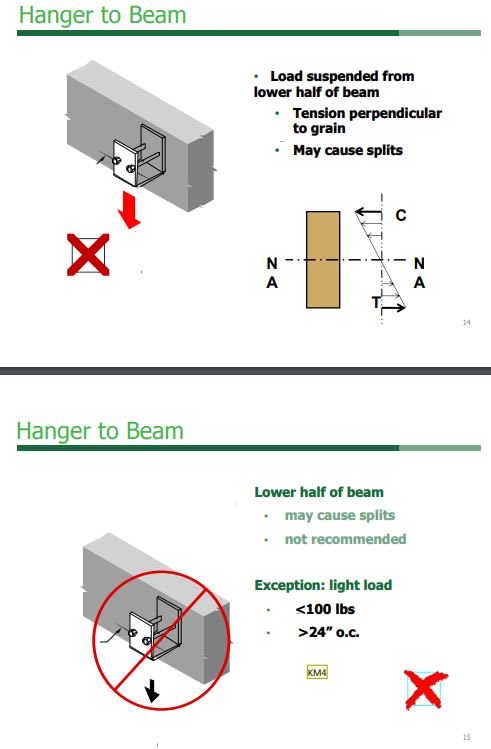
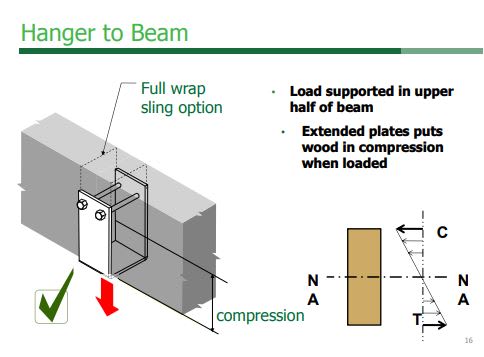


- Thread starter
- #65
I have this cabinet that is meant to hang from an LVL boxed beam using Simpson SDS screws. Half of the screws are above the neutral axis.
I only need those screws for the 2k demand. The ones below the neutral axis are only there for aesthetics. Should I be worried about installing the ones below the neutral axis?
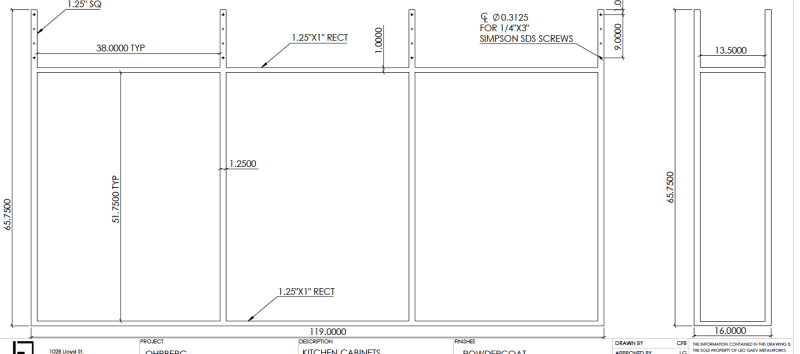

I only need those screws for the 2k demand. The ones below the neutral axis are only there for aesthetics. Should I be worried about installing the ones below the neutral axis?


It's already been discussed above, but the table below does not apply to LVLs.
Footnote 2 applies to sawn timbers and glued laminated timbers.
LVLs are not sawn timbers (2015 NDS Chapter 2)
LVLs are not glued laminated timber (2015 NDS Chapter 5).
LVLs are structural composite lumber (2015 NDS Chapter 8).
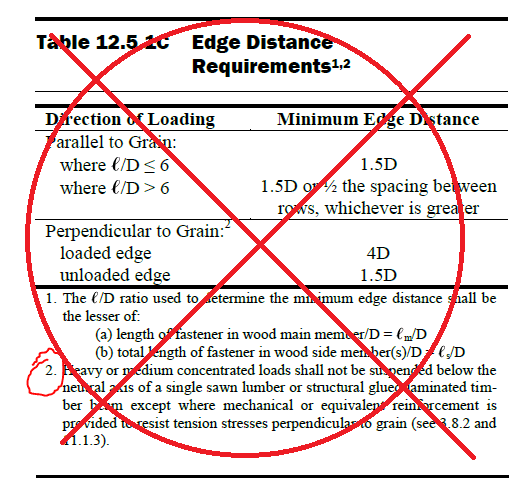
Footnote 2 applies to sawn timbers and glued laminated timbers.
LVLs are not sawn timbers (2015 NDS Chapter 2)
LVLs are not glued laminated timber (2015 NDS Chapter 5).
LVLs are structural composite lumber (2015 NDS Chapter 8).

-
2
- #68
CrabbyT, that may be, but it doesn't mean the underlying principal doesn't apply to LVLs. This is a case for engineering judgement, not blind code following. If the reason to avoid it is tension perpendicular to the grain, and an LVL has nearly perfectly aligned grain in each ply, then wouldn't it follow that you're just as likely (if not more) to develop the same tension perpendicular to the grain that you would in a piece of sawn lumber? And I don't think the glue helps that much, since it's a glue joint failure we're trying to avoid with glulams.
LVLs are proprietary products without overarching grade standards, so the NDS mostly leaves them alone and lets the manufacturer make a lot of the rules. Just because they don't specifically call this out as a problem doesn't mean it isn't. Sort of like some of the cross grain tension that develops in Simpson connectors that they don't really tell you about - not a big deal in most situations, but it can become a big deal if you push some of the larger connectors to their limits.
XR - no, I wouldn't be concerned. Most face mount connections, for instance, spread the fasteners over the whole face. The amount of tension that might develop is negated by the connector in those cases, as I believe a case could be made that the connector is acting as the necessary reinforcement of the beam there.
EDIT: CrabbyT - I just realized you crossed out the whole thing. I absolutely DISagree with that. Footnote 2 is specifically for sawn lumber and glulams (though through engineering judgement should be applied to engineered lumber as well unless the manufacturer provides evidence to the contrary). The edge distance stuff there is applicable to LVLs. Chapter 12 is not specifically for sawn lumber, it's for dowel fasteners. Chapter 8 has nothing to do with connections, just engineered lumber member design.
LVLs are proprietary products without overarching grade standards, so the NDS mostly leaves them alone and lets the manufacturer make a lot of the rules. Just because they don't specifically call this out as a problem doesn't mean it isn't. Sort of like some of the cross grain tension that develops in Simpson connectors that they don't really tell you about - not a big deal in most situations, but it can become a big deal if you push some of the larger connectors to their limits.
XR - no, I wouldn't be concerned. Most face mount connections, for instance, spread the fasteners over the whole face. The amount of tension that might develop is negated by the connector in those cases, as I believe a case could be made that the connector is acting as the necessary reinforcement of the beam there.
EDIT: CrabbyT - I just realized you crossed out the whole thing. I absolutely DISagree with that. Footnote 2 is specifically for sawn lumber and glulams (though through engineering judgement should be applied to engineered lumber as well unless the manufacturer provides evidence to the contrary). The edge distance stuff there is applicable to LVLs. Chapter 12 is not specifically for sawn lumber, it's for dowel fasteners. Chapter 8 has nothing to do with connections, just engineered lumber member design.
I try to avoid loading wood perpendicular to grain except in instances with light loadings. However, I've done this detail frequently without any issues so far, with 2 or 3 LVL ply's. I always note for the brick lintel to have 6" of bearing on brick each end to provide some rotational support. I believe the proper procedure is to check loading perpendicular to grain with a specific gravity of 0.45 (doug-fir equivalent). I use the NDS connection calculator for these instances:

 awc.org
awc.org
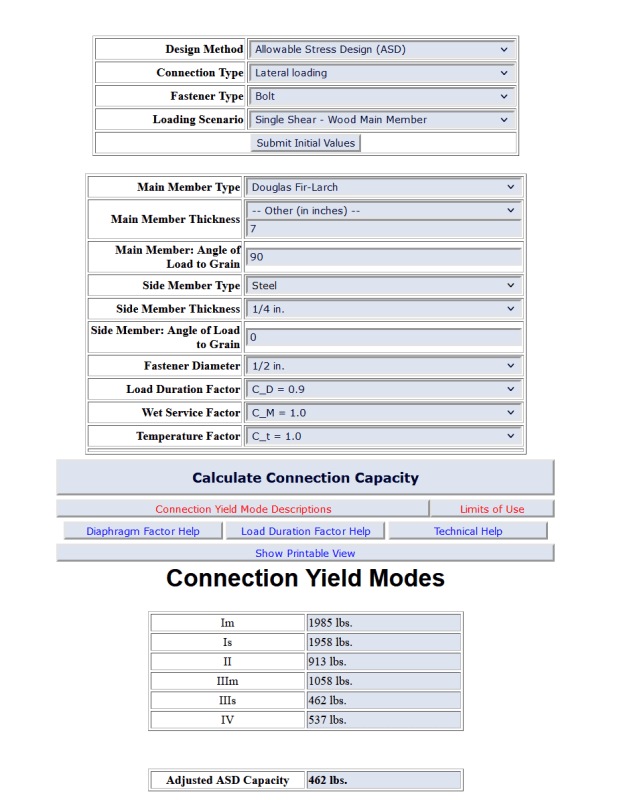

Connection Calculator
 awc.org
awc.org

- Thread starter
- #71
- Status
- Not open for further replies.
Similar threads
- Replies
- 4
- Views
- 2K
- Question
- Replies
- 11
- Views
- 6K
- Replies
- 3
- Views
- 5K
- Solved
- Replies
- 4
- Views
- 4K
- Replies
- 7
- Views
- 3K
